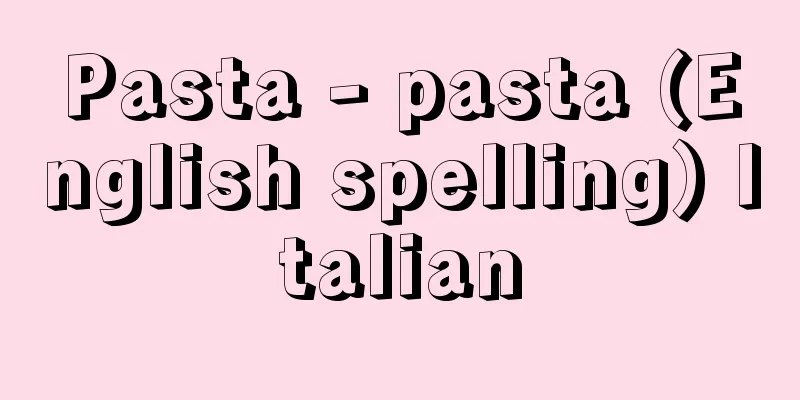Pasta - pasta (English spelling) Italian

|
The original Italian meaning of the term is dough made by kneading wheat flour with water or other liquid, but in a broader sense it is a general term for both dried pasta such as macaroni and spaghetti made from hard and soft wheat flour, and fresh pasta such as ravioli, lasagna, and cannelloni. [Nobuo Nishimura] historyThe word "pasta" was first used in Japan in the June 1965 publication of "Italian Pasta no Kenkyu" (Research on Italian Pasta). Prior to that, the word "macaroni" was used instead of "pasta". As a food made by kneading wheat flour with water, pasta has a very long history, probably dating back to ancient Rome or even earlier. Fresh pasta such as gnocchi, lasagna, and ravioli was widely used in Italy in the 13th and 14th centuries. However, dried pasta was extremely valuable, as macaroni is mentioned in an inventory of assets left by a notary in Genoa in the 13th century. Around the 14th century, stores specializing in selling homemade vermicelli began to appear, and in the 16th century, presses were developed. At that time, pasta was dried in the sun, and it developed as an industry, mainly in Naples, which had a favorable climate. In the 19th century, dryers were invented, and sun drying was replaced by artificial drying. And the pasta industry is not unique to Naples; it has spread throughout Italy, and even to Switzerland, Germany, France, and, with immigrants, to America. [Nobuo Nishimura] kindsSince pasta production began to be done by machines, various shapes of pasta have become easy to make. There are spaghettini, which is slightly thinner than spaghetti, cappelli d'angelo, which means angel hair and is even thinner and used for soups, penne, which is shaped like the tip of a pen, rigatoni, which is a size thicker than macaroni and has ridges on the surface, nido, which is like a bird's nest, rumache, which is like an escargot, farfalle, which is like a butterfly, stelline, which is a star-shaped pasta used to float soups, semi di grano, which is like an ear of wheat, and conchiglie, which is shaped like a shell. There are various types of fresh pasta, such as tagliatelle, which is similar to Japanese himokawa, fettuccine, which is like kishimen noodles, agnolotti, which is similar to ravioli, cappelletti, which is named after its hat-like shape, and pappardelle, which is a little wider than fettuccine. [Nobuo Nishimura] cookingPasta dishes are said to be representative of Italian cuisine, and there are hundreds of pasta dishes with regional characteristics from Venice in the north to Sicily in the south. Pasta dishes, which used to be a great treat in themselves, have now become merely one of the lunch or dinner courses. However, this does not mean that pasta dishes have lost their importance. On the contrary, pasta dishes are where the skills of a housewife can be shown. One of the conditions for a housewife is to master the cooking methods and sauce making methods handed down in the region where she lives. In Italy, meat and fish are often simply cooked by grilling or sauteing, and seasonings such as salt, lemon juice, and olive oil are used to emphasize the natural flavors. However, there are many types of pasta sauces, and many of them are rich in regional color. This is closely related to the fact that Italian culture is a polycentric culture that developed around each city, and that pasta has been a basic food for Italians since ancient times. In Campania, where sweet, ripe, high-quality tomatoes are grown in abundance, a tomato-based Neapolitan sauce developed. This sauce is known as Napolitan in Japan. In Bologna, a meat distribution center, Bolognese sauce, also known as meat sauce, developed. In the Liguria region, where basil is well-suited for cultivation, pesto genovese was invented, using basil and pine nuts, and in Sicily a sauce is made using sardines, a specialty of the island. Not only the sauce but also the ingredients inside show regional flavor. Sea foods such as clams, mussels and squid are often used in coastal areas, while inland mountain produce such as mushrooms and carrots are used. [Nobuo Nishimura] [References] | | | | |The main types of long pasta. From top to bottom, there are vermicelli (also called vermicelli, with a diameter of around 1.0 to 1.2 mm), spaghettini (with a diameter of around 1.4 to 1.6 mm), and spaghetti (with a diameter of around 1.6 to 1.9 mm). ©Shogakukan "> Pasta (long pasta) The top one is Cappelli d'Angelo (also called Capelli d'Angelo, diameter approx. 1.0 mm), and the bottom one is Cappellini (also called Capellini, diameter approx. 1.0-1.1 mm). ©Shogakukan "> Pasta (extra thin long pasta) The top is bucatini (diameter 2-3mm), the bottom is zite (also called long macaroni, diameter 5-8mm) ©Shogakukan "> Pasta (long tubular pasta) Long pasta with a unique cross-sectional shape. From top to bottom, linguine (oval cross-section), sberzini (triangular cross-section), and quick-cooking spaghetti (having a V-shaped groove running lengthwise). ©Shogakukan "> Pasta (long pasta with irregular cross section) Flat long pasta with a width of about 5 to 10 mm. Also called tagliatelle. From the left, tomato and egg, spinach, and egg are kneaded into the pasta ©Shogakukan "> Pasta (Tagliatelle) Flat, long pasta in a strip shape, about 20 mm wide ©Shogakukan "> Pasta (Pappardelle) Long pasta with flat noodles about 10 to 15 mm wide and pleated on both sides . ©Shogakukan Pasta (Lasagne Ricci) Short pasta with a tubular shape of 3 to 5 mm in diameter and a thickness of about 1 mm. ©Shogakukan "> Pasta (macaroni) Cylindrical short pasta with a diameter of 20-30 mm and a length of approximately 60-100 mm ©Shogakukan "> Pasta (maniche) Short pasta with a cylindrical shape, about 8 to 15 mm in diameter, and ridged on the surface . ©Shogakukan Pasta (Rigatoni) Short pasta with both ends cut diagonally like the tip of a pen . ©Shogakukan Pasta (Penne) Short spiral pasta that looks like a spring or rope ©Shogakukan "> Pasta (Fusilli) Short pasta made by twisting cylindrical pasta into a spiral shape ©Shogakukan "> Pasta (Cavatappi) Small pasta in the shape of the alphabet. The photo includes number-shaped pasta, numero . ©Shogakukan Pasta (Alphabetti) Small elephant-shaped pasta ©Shogakukan "> Pasta (Elephanti) Hat-shaped short pasta ©Shogakukan "> Pasta (Cappelletti) A short pasta with a shell shape and ridges on the surface. It is also called conchiglie or shell. ©Shogakukan "> Pasta (conchiglie) Small pasta in the shape of numbers ©Shogakukan "> Pasta (Numero) Butterfly-shaped short pasta. The photo shows different sizes and ingredients. ©Shogakukan "> Pasta (farfalle) Small pasta shaped like rice grains. There are varieties that resemble long-grain and short-grain rice. ©Shogakukan "> Pasta (Lisoni) Wheel-shaped short pasta. Also called wheel or rotelle. The photo shows a wheel with ridges on the circumference. ©Shogakukan "> Pasta (Ruote) A short pasta shaped like an escargot (snail) with ridges on the surface. It is also called rumacone. Larger versions of rumacone are called rumache. ©Shogakukan "> Pasta (Lumaquinho) Small flower-shaped pasta ©Shogakukan "> Pasta (Rosellino) A thick cylindrical pasta with a diameter of 20 to 40 mm and a length of about 100 mm, made especially for the pasta dish Cannelloni. It is also called Cannelloni, Cannelloni, Cannelloni, or Cannelloni . Originally, ingredients were placed on a rectangular sheet of fresh pasta dough and rolled up, but cylindrical dried pasta is also available on the market, and ingredients are stuffed into the tube . Pasta (Cannelone) Thin, plate-shaped pasta with a width of 60-80 mm and a standard length of around 120-150 mm. Also called lasagna. ©Shogakukan "> Pasta (lasagna) Source: Shogakukan Encyclopedia Nipponica About Encyclopedia Nipponica Information | Legend |
|
イタリア語の原義は、小麦粉を水などの液体でこねた練り粉のことであるが、広義には硬質および軟質の小麦粉でつくるマカロニ、スパゲッティなどの乾燥パスタと、ラビオーリ、ラザーニャ、カネローネなどの生パスタの両方を総称することばである。 [西村暢夫] 歴史日本でパスタということばが使われたのは、1965年(昭和40)6月に刊行された『イタリアパスタの研究』が最初である。それ以前はマカロニということばでパスタを代用させていた。小麦粉を水で練った食物という意味ではパスタの歴史は非常に古く、おそらく古代のローマあるいはそれ以前までさかのぼることができるであろう。13、4世紀のイタリアではニョッキ、ラザーニャ、ラビオーリのような生パスタが一般にかなり普及していたと考えられる。しかし乾燥パスタのほうはきわめて貴重なものであったらしく、13世紀のジェノバの公証人の残した財産目録にマカロニのことが記されている。14世紀ごろから自家製ベルミチェッリを専門に売る店ができ始め、16世紀には圧力機(プレス)が出現する。そのころパスタの乾燥は天日乾燥であり、気候の点で恵まれたナポリを中心に産業として発展していった。19世紀になると乾燥機が発明され、天日乾燥から人工乾燥へ変わっていった。そしてパスタ産業はナポリ特有のものではなく、イタリア全土へ、さらにはスイス、ドイツ、フランス、そして移民とともにアメリカへも普及していった。 [西村暢夫] 種類パスタの製造が機械で行われるようになってから、さまざまな形状のパスタが簡単につくられるようになった。スパゲッティよりもやや細めのスパゲッティーニ、天使の髪という意味で、さらに細くスープ用に使われるカッペリ・ダンジェロ、ペン先のような形をしているペンネ、マカロニよりひと回り太くて表面に筋(すじ)のあるリガトーニ、鳥の巣状のニード、エスカルゴ状のルマーケ、蝶(ちょう)の形のファルファッレ、スープの浮き実用に使われる星の形をしたステッリーネ、麦の穂状のセーミ・ディ・グラーノ、貝の形のコンキリエなどである。生パスタとしては、日本のひもかわに似たタリアテッレ、きしめん状のフェットチーネ、ラビオーリに似たアニョロッティ、帽子の形に似ているのでその名のついたカッペッレッティ、フェットチーネより少し幅の広いパッパルデッレなどいろいろある。 [西村暢夫] 料理パスタ料理はイタリア料理を代表するものであるといわれるように、北はベネチアから南はシチリアまで各地方ごとの特徴をもつパスタ料理が何百もある。古くはそれ自体たいへんな御馳走(ごちそう)であったパスタ料理が、いまでは昼食や夕食のコースの一品にすぎなくなってしまった。しかしそれは、パスタ料理の重要性が失われたということではない。むしろその逆で、パスタ料理こそ家庭の主婦の腕の見せどころである。とくに自分の住んでいる地方に伝わる料理法、各種ソースの作り方をマスターすることが主婦の条件の一つである。イタリアでは肉や魚は焼くかソテーするかの簡単な料理が多く、味つけも塩、レモン汁、オリーブ油などを用いて自然の持ち味をたいせつにする。ただし、パスタのソースは種類も豊富で、かつ地方色豊かなものが多い。それは、イタリア文化が各都市を中心に発展した多中心の文化であることと密接なかかわりがあるし、パスタが古い昔からのイタリア人にとって基本的な食物であったことと関係がある。 甘く熟した良質のトマトのたくさんとれるカンパニア州では、トマトをベースにしたナポリ風ソースが発達した。いわゆるナポリタンと日本でよばれているソースである。肉類の集散地ボローニャではボロニェーゼソース、いわゆるミートソースが発達した。バジリコの栽培に適したリグリア地方では、バジリコとマツの実を使ったペスト・ジェノベーゼが生まれ、シチリアでは島の特産であるイワシを使ったソースがつくられる。 ソースだけでなく、中に入る具にも地方色が出てくる。海に面した地方ではアサリやムールガイやイカなどの海産物をよく使い、内陸ではキノコやニンジンなどの山の幸が使われている。 [西村暢夫] [参照項目] | | | | |ロングパスタのおもなもの。上からベルミチェッリ(バーミセリともいう。直径1.0~1.2mm前後)、スパゲッティーニ(直径1.4~1.6mm前後)、スパゲッティ(直径1.6~1.9mm前後)©Shogakukan"> パスタ(ロングパスタ) 上はカッペリ・ダンジェロ(カペッリ・ダンジェロともいう。直径1.0mm前後)、下はカッペリーニ(カペッリーニともいう。直径1.0~1.1mm前後)©Shogakukan"> パスタ(極細ロングパスタ) 上はブカティーニ(直径2~3mm前後)、下はツィーテ(ロングマカロニともいう。直径5~8mm前後)©Shogakukan"> パスタ(管状ロングパスタ) 麺の断面形状が特殊なロングパスタ。上からリングイーネ(断面が楕円形)、ズベルズィーニ(断面が三角形)、早ゆでスパゲッティ(長さ方向にV字形の溝がある)©Shogakukan"> パスタ(変形断面ロングパスタ) 幅5~10mm前後の平麺ロングパスタ。タッリアテッレともいう。左から、トマトと卵、ホウレンソウ、卵をそれぞれ練り込んだもの©Shogakukan"> パスタ(タリアテッレ) 幅20mm前後の帯状の平麺ロングパスタ©Shogakukan"> パスタ(パッパルデッレ) 幅10~15mm前後の平麺で、両側にひだの入ったロングパスタ©Shogakukan"> パスタ(ラザニェッテ・リッチェ) 直径3~5mmの管状で、厚さが1mm前後のショートパスタ©Shogakukan"> パスタ(マカロニ) 直径20~30mm、長さ60~100mm前後の円筒状ショートパスタ©Shogakukan"> パスタ(マニケ) 直径8~15mm前後の円筒状で、表面に筋が入るショートパスタ©Shogakukan"> パスタ(リガトーニ) 円筒状パスタの両端をペン先のように斜めにカットしたショートパスタ©Shogakukan"> パスタ(ペンネ) ばねあるいは縄状にみえる螺旋形のショートパスタ©Shogakukan"> パスタ(フジッリ) 円筒状パスタを螺旋状にねじったショートパスタ©Shogakukan"> パスタ(カバタッピ) アルファベットの形をしたスモールパスタ。写真には数字の形をしたパスタ、ヌーメロが含まれている©Shogakukan"> パスタ(アルファベーティ) ゾウの形をしたスモールパスタ©Shogakukan"> パスタ(エレファンティ) 帽子の形をしたショートパスタ©Shogakukan"> パスタ(カッペッレッティ) 貝形で、表面に筋が入るショートパスタ。コンキッリエ、シェルともいう©Shogakukan"> パスタ(コンキリエ) 数字の形をしたスモールパスタ©Shogakukan"> パスタ(ヌーメロ) 蝶の形をしたショートパスタ。写真は大きさと練り込んだ材料が異なるもの©Shogakukan"> パスタ(ファルファッレ) 米粒の形をしたスモールパスタ。長粒米、短粒米を模したものがある©Shogakukan"> パスタ(リソーニ) 車輪形のショートパスタ。ホイール、ロテッレともいう。写真は円周に筋が入ったもの©Shogakukan"> パスタ(ルオーテ) エスカルゴ(カタツムリ)の形をした、表面に筋が入るショートパスタ。ルマコーネともいう。ルマキーネの大形のものはルマーケという©Shogakukan"> パスタ(ルマキーネ) 花の形をしたスモールパスタ©Shogakukan"> パスタ(ロゼッリーネ) パスタ料理カネローネ専用の直径20~40mm、長さ100mm前後の太い円筒状のパスタ。カンネッローネ、カンネッローニ、カネローニ、カネロニともいう。本来は長方形のシート状の生パスタ生地に具材を敷いて巻き込むが、円筒状の乾燥パスタも市場に出回っており、筒の中に具材を詰めて使用する©Shogakukan"> パスタ(カネローネ) 幅60~80mm、標準的な長さが120~150mm前後の薄い板状のパスタ。ラザーニェともいう©Shogakukan"> パスタ(ラザーニャ) 出典 小学館 日本大百科全書(ニッポニカ)日本大百科全書(ニッポニカ)について 情報 | 凡例 |
Recommend
Self-help - self-help
When one's rights are violated, the act of eli...
anonymous galaxy
...The most extensive catalogue is the Catalog of...
Ota River Improvement Project - Ota River Improvement Project
…During the feudal era, water transport, mainly o...
Dorylinae
…General term for ants belonging to the family Fo...
Tucson - Tou-son (English spelling) Tucson
A tourist and recreational city in southeastern A...
two ball foursome
…(1) Two ball threesome: Match play in which two ...
Amynodon (English spelling)
An extinct mammal related to the rhinoceros. It wa...
Leo 32 - Leo 32
Along with the Panchatantra and the 25 Tales of th...
Yi Yi - Igei
…A heroic deity of Yi origin that appears in Chin...
Huang Gongwang - High School
A Chinese painter from the Yuan Dynasty who was n...
Hepatolithiasis
What is the disease? Intrahepatic stones are ston...
War film
A general term for films that depict battlefields ...
Apeoi - Apeoi
…Historically, Japanese homes have always had a s...
Kuji River
A river that flows through northern Ibaraki Prefec...
Ejima (person's name) - Ejima
...A type of Kabuki Kyogen. Based on the love sto...









